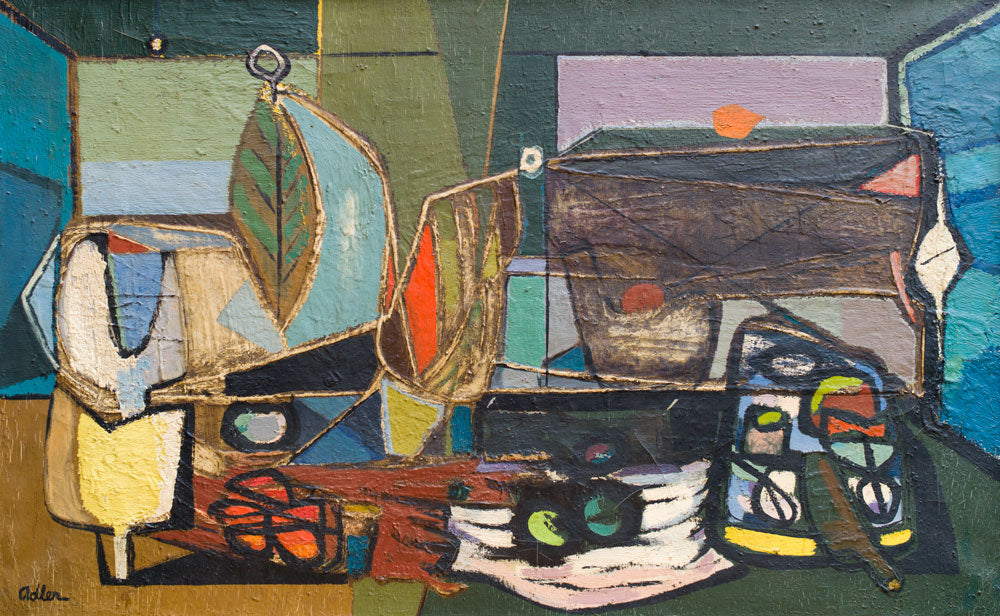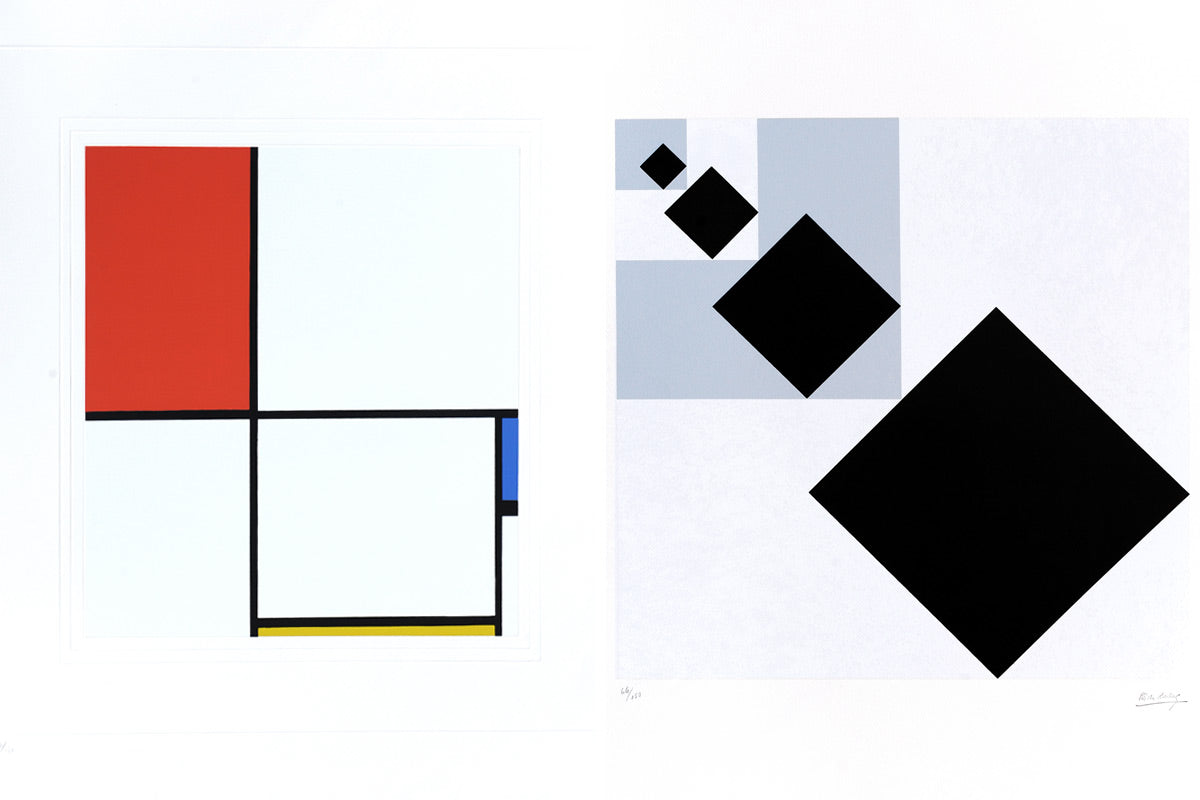Traced back to its Roman origins, the word ‘abstract’ means literally to ‘drag’ or ‘draw’ something away. Its etymological root in Latin is quite forceful, occasionally even violent; not gentle diversion or digression but a purposeful motion of distancing and detaching, extraction and relocation.
So too with abstract art. When in the early 1910s and ‘20s abstraction emerged on the scene, the art world was in a state of constant revolution and trenchant division. Factions of ‘isms’ fought against each other for claims of artistic truths: Impressionism had given way to the anger and energy of Expressionism, while Cubists, Vorticists, Futurists et al. tussled over the crown of modern art theory and aesthetics.
 abstract composition from 1932 by Russian artist Wassily Kandinsky
abstract composition from 1932 by Russian artist Wassily Kandinsky
In truth, abstract art is far older than we think, dating back to the simplified geometric patterns and designs made by primitive man on cave walls. Traditionally, however, abstraction is thought to have emerged from Expressionism at the hand of recent research has suggested even this may not be the case), for whom the arrangement of shape and colour represented a way visually into our spiritual and emotional aspects.
The basis of Expressionist art – to depict not merely figurative scenes but our very moods and emotions in pictorial form – made for a natural progression towards the abstract. From a technical viewpoint, Expressionism laid the groundwork for abstraction: it involved bold use of vivid colours, often in crude or non-naturalistic brushstrokes, and a reduction of images to increasingly simplified designs to heighten the impact of colour and form.
 early Abstract / Expressionist work by Kandinsky highlighting the movement's use of bold colours and forms
early Abstract / Expressionist work by Kandinsky highlighting the movement's use of bold colours and forms
From a theoretical perspective, this move towards the abstract seemed almost inevitable. The very things Expressionists wished to convey in their art – sensations and emotions – were themselves ‘abstract’ notions, intangible and essentially indefinable. That an abstract subject would demand an abstract mode of expression seemed a natural progression of thought.
As the first truly abstract works began to appear in the mid-1910s, however, it became clear that attitudes and approaches to abstraction would be as divided and contested as the movements from which they followed.
 still life by Polish artist Jankel Adler; Adler produced many figurative / abstract works in the late 1930s-'40s in which everyday objects are distorted and reinterpreted through an abstracting eye
still life by Polish artist Jankel Adler; Adler produced many figurative / abstract works in the late 1930s-'40s in which everyday objects are distorted and reinterpreted through an abstracting eye
For some artists, abstract art was a matter of simplifying and stylising the figurative until it became no longer immediately recognisable. Movements such as Cubism and Futurism had already begun to fragment, distort and break down their subjects into dynamic forms and designs when creating their images; abstraction for these artists became the logical extension of their earlier methods.
 (above) geometric designs by founders of the Dutch 'Neo-Plasticism' or 'De Stijl' movement Piet Mondrian (left) and Théo van Doesburg; (below) rectangular and rectilinear De Stijl arrangements by Jean Gorin (left) and Georges Vantongerloo (right)
(above) geometric designs by founders of the Dutch 'Neo-Plasticism' or 'De Stijl' movement Piet Mondrian (left) and Théo van Doesburg; (below) rectangular and rectilinear De Stijl arrangements by Jean Gorin (left) and Georges Vantongerloo (right)

For others, abstract art represented a purer mode of depiction entirely detached from the world of figurative art. Artists such as Kazimir Malevich, László Moholy-Nagy, and Piet Mondrian began to experiment with geometric shapes and designs that had no reference in the real world and were totally non-representational, employing coordinated colour, shape and line in strict geometric compositions.
 (above) angular forms in a Nagy print; (below) a sculptural abstract form features in this Alexander Calder print
(above) angular forms in a Nagy print; (below) a sculptural abstract form features in this Alexander Calder print

Despite their stylistic differences, both styles of abstraction were ultimately concerned with the same sense of development, of withdrawing from the distractions of representation to aim at something more powerful and substantial within or beyond our immediate environment: since it did not reflect or represent the real world, abstract art was thus felt connected to the spiritual or the intellectual realm, the world of visual theory and harmony, and of perfect, pure or Platonic forms. Abstraction was, for these artists, the natural conclusion of art.
 (above) geometric composition by Swiss artist Hans Erni; (below) prints by Jean Villeri (left) and Paule Vézelay (right)
(above) geometric composition by Swiss artist Hans Erni; (below) prints by Jean Villeri (left) and Paule Vézelay (right)

Following these very first examples of abstract art – Kandinsky’s Abstract Expressionism, Malevich’s Black Square and Mondrian’s grids of colour – came a wave of abstract methods and styles which dominated the art world right until the explosion of pop art in the late 1950s and early ‘60s.
 (above) Miró's Abstract Surrealism blends figures and forms in this lithograph; (below) harmonies of colour and line in prints by Sonia Delaunay (left) and Victor Vasarely (right)
(above) Miró's Abstract Surrealism blends figures and forms in this lithograph; (below) harmonies of colour and line in prints by Sonia Delaunay (left) and Victor Vasarely (right)

Orphism under Sonia and Robert Delaunay sought to express pure harmonies between colour and shape; abstraction was allied to the unconscious mind in Miró’s Abstract Surrealism and the 'automatic' splatter paintings of Jackson Pollock; colour fields alone provoked meditation in Rothko, while geometric order was championed in the Op Art of Vasarely. And between each subsequent abstract movement slipped artists whose works remained untied to any one school of thought, such as the carefully composed prints of Victor Pasmore, one of Britain’s most important abstract artists.
 the considered composition of a Pasmore screenprint
the considered composition of a Pasmore screenprint
Abstract art was not quietly ushered through the back door of art history; it was proclaimed, loud and true, by countless parties and offered up in a wealth of guises by artists approaching abstraction from a great variety of perspectives. That its impact is still felt today is testament to the extraordinary way in which it changed the landscape of the art world in the early years of the 20th century.










